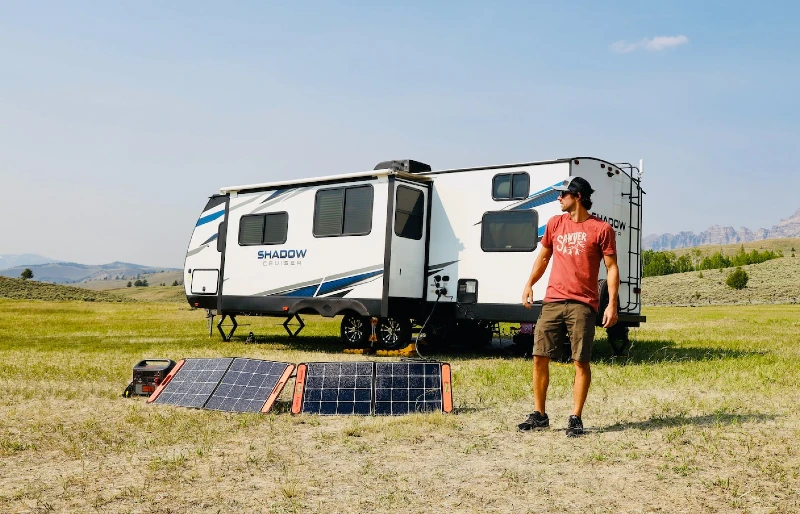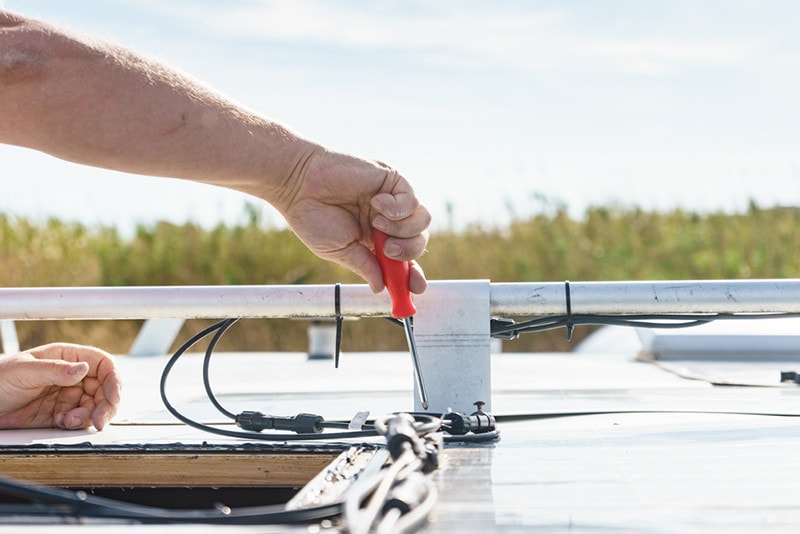How to Hook Up Solar Panels to RV Batteries: 7 Easy Steps
-
Chris Dinesen Rogers
- Last updated:

If you’re like 75% of Americans, camping offers an excellent way to escape everyday stress. Whether you sleep in a tent or go RVing, this recreational activity fits the bill. Roughly 65 million people have RVing on their vacation plans, with 90% using towable rigs. Camping has evolved into a lifestyle for some. They aren’t content with staying at a campground. They want to experience the wilderness.
According to the 2021 North American Camping Report, about 5% of the year’s camping nights were spent boondocking. That makes supplying your own energy with a solar power system essential. Our guide will explain how to install them on your rig, with tips for getting the most out of this green form of energy.
Before You Start
Before starting this project, you should consider several factors. How frequently do you camp? You may find that portable solar panels are a better investment than mounting them to your rig. Of course, that will affect how you hook them up to your RV batteries.
You should also think about what you’re going to power. If you only need something to charge smart devices, the chances are you can get by with a more modest system. Likewise, winter and summer outings mean more electricity to keep you comfortable.
Finally, consider where you usually camp. The National Renewable Energy Laboratory (NREL) publishes maps detailing average monthly sun hours to help you figure out how much power you’re going to need based on your itinerary. It may also help you plan your trips to make optimal use of your solar power system.

Materials
Solar power has come a long way since its inception until things took off in 2012. The technology improved while prices decreased, making this option affordable for RVers. Nevertheless, no energy form is 100% efficient. That’s where your batteries step up to the plate. They will help you take advantage of an excess to use later. The things you need to connect your system include:
- Solar panel(s)
- Battery or battery bank
- Charge controller
- Inverter (optional)
The 7 Easy Steps to Hook Up Solar Panels to RV Batteries
1. Determine Your Energy Needs
We strongly urge you to do the math to make sure you have sufficient power to run your rig. It’s the ideal time if you’re opting for a permanent installation. You can upgrade your battery or battery bank if necessary. The average American household uses roughly 30 kWh per day. A rule of thumb is to match the batteries’ amp-hours with some wiggle room with the total watts of the solar panels.
The extra amp hours cover the things you can’t control, like the weather, sunlight hours, and the angle of the sun at your site.
2. Install the Solar Panels to Your Rig

If you opt for a permanent installation, you can start by mounting the solar panels to your RV. The process varies with the type of panels and your RV. Check them for their fit before screwing them into place. You must be able to snake the power cord into the rig, whether it’s drilling a hole or putting it through your fridge vent.
3. Install the Charge Controller

The charge controller is essential for ensuring you don’t overcharge your batteries and decrease their lifespan. You’ll find either pulse width modulation (PWM) or maximum power point tracking (MPPT) products. Each has its pros and cons. The PWM is the older but more affordable technology. The latter can save you money in the long run if you use a lot of juice or go winter camping.
You should install it as close to your battery bank as you can to minimize loss. It also optimizes your use of space in the relatively small confines of an RV.
4. Connect Your Battery Bank to the Charge Controller
Connect your batteries to the charge controller. We suggest testing the polarity using a multimeter if it’s not marked on the device. Make sure to note them to make swapping out batteries easier when they die.
Pro Tip: Check the manufacturer’s instructions before connecting anything. Some may specify a certain order for the solar panels, batteries, charge controller, and inverter.
5. Mount the Inverter (Optional)

If your RV has AC appliances, then you’ll need an inverter. The solar power system generates DC, which this device will convert to AC. Again, follow the manufacturer’s directions for the order of these connections. The ideal location for this device is close to the batteries. Then, hook it up to your rig’s electrical system, starting with the negative wire.
6. Connect the Solar Panels to the Charge Controller

The last installation step is making this final connection between the solar panels and the charge controller. We suggest either covering the former with a tarp or doing it at night when there is less risk of a spark. The latter should display the voltage of the panels. However, remember that they don’t have an on-off switch. They work when they’re receiving sunlight.
7. Get the Most Out of Your Solar Power System
You probably don’t pay too close attention to your electricity usage at home. However, a solar power setup has limitations, so it makes sense to optimize power usage. We recommend replacing any light bulbs with LEDs as necessary. If you’re in the market for a new appliance, always get Energy Star models.
Finally, make sure to keep your solar panels clean. You can make it a routine to clean them before going out on a trip. It’s worth noting that dirty panels can reduce their energy production by up to 20%. Luckily, many systems include smart technology, alerting you to issues like maintenance before they become problems.
Conclusion
A solar power system gives you the freedom to camp where you want to without having to worry about meeting your rig’s energy needs. The installation of the panels and your battery bank isn’t difficult, making it easy to go boondocking when the travel bug nags at you. The essential thing is to follow the manufacturer’s directions to the letter. Regular maintenance will ensure reliable power wherever you go.
- https://www.statista.com/statistics/416883/leading-reasons-for-camping-north-america/
- https://rvia.guerrillaeconomics.net/reports/
- https://www.nrel.gov/gis/solar-resource-maps.html
- https://www.statista.com/statistics/183443/us-electricity-generation-from-selected-renewable-sources-since-2000/
- https://www.eia.gov/tools/faqs/faq.php?id=97&t=3
- https://www.energystar.gov/products
- https://ep.liu.se/ecp/057/vol11/039/ecp57vol11_039.pdf
Featured Image Credit: Voyagerix, Shutterstock
Contents

